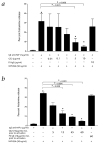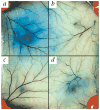A novel human immunoglobulin Fc gamma Fc epsilon bifunctional fusion protein inhibits Fc epsilon RI-mediated degranulation
- PMID: 11984598
- PMCID: PMC1866216
- DOI: 10.1038/nm0502-518
A novel human immunoglobulin Fc gamma Fc epsilon bifunctional fusion protein inhibits Fc epsilon RI-mediated degranulation
Abstract
Human mast cells and basophils that express the high-affinity immunoglobulin E (IgE) receptor, Fc epsilon receptor 1 (Fc epsilon RI), have key roles in allergic diseases. Fc epsilon RI cross-linking stimulates the release of allergic mediators. Mast cells and basophils co-express Fc gamma RIIb, a low affinity receptor containing an immunoreceptor tyrosine-based inhibitory motif and whose co-aggregation with Fc epsilon RI can block Fc epsilon RI-mediated reactivity. Here we designed, expressed and tested the human basophil and mast-cell inhibitory function of a novel chimeric fusion protein, whose structure is gamma Hinge-CH gamma 2-CH gamma 3-15aa linker-CH epsilon 2-CH epsilon 3-CH epsilon 4. This Fc gamma Fc epsilon fusion protein was expressed as the predicted 140-kappa D dimer that reacted with anti-human epsilon- and gamma-chain specific antibodies. Fc gamma Fc epsilon bound to both human Fc epsilon RI and Fc gamma RII. It also showed dose- and time-dependent inhibition of antigen-driven IgE-mediated histamine release from fresh human basophils sensitized with IgE directed against NIP (4-hydroxy-3-iodo-5-nitrophenylacetyl). This was associated with altered Syk signaling. The fusion protein also showed increased inhibition of human anti-NP (4-hydroxy-3-nitrophenylacetyl) and anti-dansyl IgE-mediated passive cutaneous anaphylaxis in transgenic mice expressing human Fc epsilon RI alpha. Our results show that this chimeric protein is able to form complexes with both Fc epsilon RI and Fc gamma RII, and inhibit mast-cell and basophil function. This approach, using a Fc gamma Fc epsilon fusion protein to co-aggregate Fc epsilon RI with a receptor containing an immunoreceptor tyrosine-based inhibition motif, has therapeutic potential in IgE- and Fc epsilon RI-mediated diseases.
Figures



Similar articles
-
Genetically engineered negative signaling molecules in the immunomodulation of allergic diseases.Curr Opin Allergy Clin Immunol. 2004 Dec;4(6):563-8. doi: 10.1097/00130832-200412000-00015. Curr Opin Allergy Clin Immunol. 2004. PMID: 15640700 Review.
-
Transgenic mice expressing the human high-affinity immunoglobulin (Ig) E receptor alpha chain respond to human IgE in mast cell degranulation and in allergic reactions.J Exp Med. 1996 Jan 1;183(1):49-56. doi: 10.1084/jem.183.1.49. J Exp Med. 1996. PMID: 8551243 Free PMC article.
-
Fc epsilon receptor I-associated lyn-dependent phosphorylation of Fc gamma receptor IIB during negative regulation of mast cell activation.J Immunol. 1998 Feb 15;160(4):1647-58. J Immunol. 1998. PMID: 9469421
-
Regulation of high-affinity IgE receptor-mediated mast cell activation by murine low-affinity IgG receptors.J Clin Invest. 1995 Feb;95(2):577-85. doi: 10.1172/JCI117701. J Clin Invest. 1995. PMID: 7860741 Free PMC article.
-
Proximal signaling events in Fc epsilon RI-mediated mast cell activation.J Allergy Clin Immunol. 2007 Mar;119(3):544-52; quiz 553-4. doi: 10.1016/j.jaci.2007.01.017. J Allergy Clin Immunol. 2007. PMID: 17336609 Review.
Cited by
-
Blockade of peanut allergy with a novel Ara h 2-Fcγ fusion protein in mice.J Allergy Clin Immunol. 2013 Jan;131(1):213-21.e1-5. doi: 10.1016/j.jaci.2012.10.018. Epub 2012 Nov 27. J Allergy Clin Immunol. 2013. PMID: 23199607 Free PMC article.
-
Expression profiling of the cellular processes in uterine leiomyomas: omic approaches and IGF-2 association with leiomyosarcomas.Cancer Res Treat. 2004 Feb;36(1):31-42. doi: 10.4143/crt.2004.36.1.31. Epub 2004 Feb 29. Cancer Res Treat. 2004. PMID: 20396563 Free PMC article.
-
Decoding IgE Fc receptors.Immunol Res. 2007;37(1):1-16. doi: 10.1007/BF02686092. Immunol Res. 2007. PMID: 17496343 Review.
-
Immunoglobulin E receptor signaling and asthma.J Biol Chem. 2011 Sep 23;286(38):32891-7. doi: 10.1074/jbc.R110.205104. Epub 2011 Jul 28. J Biol Chem. 2011. PMID: 21799019 Free PMC article. Review.
-
Murine B cells regulate serum IgE levels in a CD23-dependent manner.J Immunol. 2010 Nov 1;185(9):5040-7. doi: 10.4049/jimmunol.1001900. Epub 2010 Sep 24. J Immunol. 2010. PMID: 20870945 Free PMC article.
References
-
- Ott VL, Cambier JC. Activating and inhibitory signaling in mast cells: New opportunities for therapeutic intervention? J Allergy Clin Immunol. 2000;106:429–440. - PubMed
-
- Ravetch JV. Fc receptors. Curr Opin Immunol. 1997;9:121–125. - PubMed
-
- Daeron M, et al. The same tyrosine-based inhibition motif, in the intracytoplasmic domain of FcγRIIB, regulates negatively BCR-, TCR-, and FcR-dependent cell activation. Immunity. 1995;3:635–646. - PubMed
-
- Oliver JM, Kepley CL, Ortega E, Wilson BS. Immunogically mediated signaling in basophils and mast cells: Finding therapeutic targets for allergic diseases in the human FcεRI signaling pathway. Immunopharmacology. 2000;48:269–281. - PubMed
Publication types
MeSH terms
Substances
Grants and funding
LinkOut - more resources
Full Text Sources
Other Literature Sources
Medical
Miscellaneous

